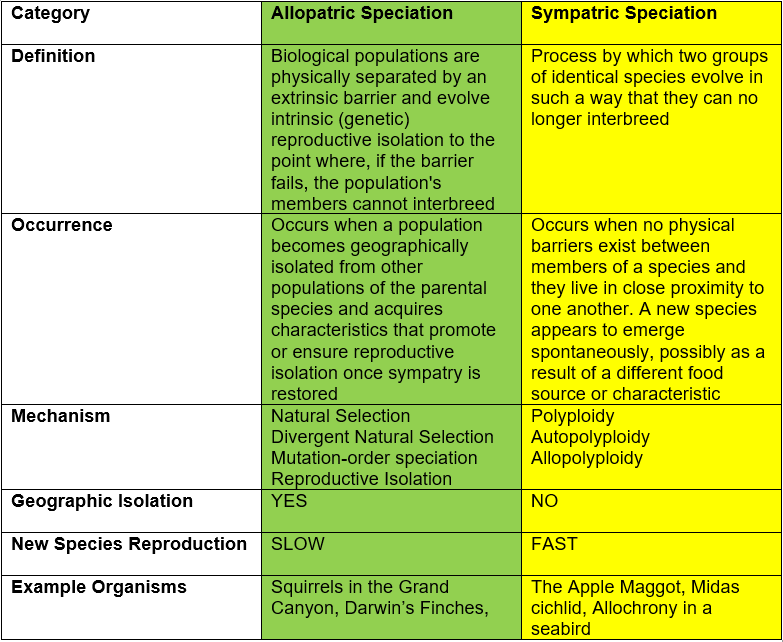Biology Forum › Ecology › Sympatric vs allopatric speciation
- AuthorPosts
- August 4, 2021 at 5:45 am #118426
 Jenel PonceParticipant
Jenel PonceParticipantWhat is the difference between allopatric and sympatric speciation? Allow me to discuss with you the difference between the two terms. Sympatric and allopatric speciation differ in many aspects such as its occurrence, mechanisms, geographic isolation, and species reproduction. Below is the comparison chart between them.
Comparison chart: Sympatric vs allopatric speciation

Figure 1: Comparison chart: Sympatric vs allopatric speciation
What is allopatric speciation? Let’s define it below.
Allopatric speciation
Definition: Allopatric speciation is a type of speciation in which biological populations are physically separated by an extrinsic barrier and evolve intrinsic (genetic) reproductive isolation to the point where, if the barrier fails, the population’s members cannot interbreed.
In the majority of animal taxa, allopatric speciation is widely believed to be the most likely mechanism of speciation. Allopatry occurs when a population becomes geographically isolated from other populations of the parental species and acquires characteristics that promote or ensure reproductive isolation once sympatry is restored.
Allopatric speciation example: This can happen when a physical barrier, such as a new river, divides a species’ geographic range. If the barrier is sufficiently large, gene flow between them is halted, and the two distinct populations evolve independently. If the two populations are separated for a long enough period of time that significant divergence occurs; when the barrier is removed and the populations are reunited, they may retain their distinct characteristics. They would be prevented from interbreeding through a prezygotic or postzygotic isolation mechanism. There would now be two distinct species where previously there was only one.
More of Allopatric Speciation here: https://www.biologyonline.com/dictionary/allopatric-speciation
Sympatric speciation
What is Sympatric Speciation?
Definition: Sympatric speciation (in biology) refers to the process by which two groups of identical species evolve in such a way that they can no longer interbreed. It enables the evolution of new species from a common ancestor while the new and old species coexist in the same geographic region.
How does sympatric speciation occur? Sympatric speciation occurs when no physical barriers exist between members of a species and they live in close proximity to one another. A new species appears to emerge spontaneously, possibly as a result of a different food source or characteristic. According to the theory, some individuals develop an aversion to certain aspects of their environment, such as shelter or food sources, while others do not.
Sympatric Speciation Example: Sympatric speciation by allochrony in a seabird. Oceanodroma castro (commonly known as the Madeiran or Band-rumped storm-petrel) is a small seabird that breeds on tropical and subtropical islands in the Atlantic and Pacific Oceans. We discovered that sympatric seasonal populations are genetically distinct within each of the five archipelagos and have ceased gene exchange in two of them. Seasonal populations thus appear to have evolved sympatrically at least four times. This is the first demonstration of sympatric speciation in a tetrapod via allochrony, and it adds to a growing body of evidence that population differentiation and speciation can occur without geographic barriers to gene migration (Friesen et.al, 2007)
More of Sympatric Speciation Examples here: https://www.biologyonline.com/dictionary/sympatric-speciation
Autopolyploidy
When an individual possesses more than two sets of chromosomes, both of which originate from the same parental species, this is referred to as autopolyploidy. Polyploid species are formed when the genome of a single species (diploid) is duplicated. In plants, the allopolyploid offspring may be more robust and healthy than either parent. This is typically detrimental to biodiversity because it results in decreased diversity if the hybrid threatens the prevalence of either or both parents. The term “hybrid vigor” or “heterosis” refers to when a hybrid is stronger than the parental species.
Allopolyploidy
Allopolyploidy (biology definition) happens when a species characterizes more than two copies, but these copies were from a certain species. It occurs as a result of the fusion of two or more diploid genomes from distinct species. One possibility is that when the two species interbreed, the recessive mutations face increased selective pressure, reducing their propagation in polyploid hybrids. Additionally, recombination enables hybrids to produce more diverse progenies with a high probability of heterozygosity. The redundancy conferred by the presence of multiple copies of each gene provides an additional layer of protection against harmful mutations. Allopolyploidy is very critical in small inbreeding populations and can mean the difference between population failure and flourishing.
I hope this brings clarity as to the difference between Sympatric speciation and Allopatric speciation. If you want further clarification, please comment below and I will share with you additional insights into the topic.
- AuthorPosts
You must be logged in to reply to this topic.
